Securing and Retaining Human Resources
Basic Thoughts on Personnel
The Kawasaki Group is active worldwide through a global workforce of about 35,000 people. To achieve higher sustainable corporate value through the implementation of our mission statement, it is very important that each and every employee, regardless of nationality, gender or age, religion, or any disabilities, understand and communicate the underlying ideals of our Group Mission and Kawasaki Value and be diligent and industrious in daily tasks, based on the Group Code of Conduct. Of note, for us to reach new heights in technology, which is a component of Kawasaki Value, it is absolutely essential from a long-term perspective to ensure that human resources receive the right training. Toward this end, we have established a workplace environment in which employees pursue their duties with a positive outlook in safe and secure surroundings, and we direct concerted energy into training that fuels realization of business strategies while contributing to the future of the planet. The foundation for this approach is Group Management Principle No. 3, which reads “The Kawasaki Group’s corporate culture is built on integrity, vitality, organizational strength, and mutual respect for people throughout the entire Group.”
Composition of Workforce (As of March 31, 2018)
| Total | Men | Women | |
|---|---|---|---|
| Non-consolidated | 16,423 | 15,303 | 1,120 |
| (Managerial staff) | 3,473 | 3,345 | 28 |
| (General Employees) | 12,950 | 11,858 | 1,092 |
| Domestic group | 26,747 | ― | ― |
| Overseas group | 9,058 | ― | ― |
| Group-wide | 35,805 | ― | ― |
Note: The number of employees includes temporary employees (non-consolidated).
Personnel Data (as of March 31, 2018) (non-consolidated)
| Average age | Average years of service | Average annual salary (yen) | ||
|---|---|---|---|---|
| Non-consolidated | Men | 38.3 | 13.5 | 7,189,521 |
| Women | 39.9 | 13.5 | 5,153,445 | |
| Total | 38.4 | 13.5 | 7,067,086 | |
Securing Human Resources
When recruiting human resources, rather than simply filling posts of retiree, we seek to recruit human resources with the necessary skills in the required numbers based on a medium- to long-term view. Recently, business expansion has heightened the need for more employees, and we actively recruit new graduates as well as individuals who have already acquired career experience. Additionally, in the course of our attempt to employ new overseas college graduates and foreign national students starting in fiscal year ended March 31, 2013 with a view to overseas business extension and respect for diversity, three foreign national students joined us in fiscal year ending March 31, 2019.
New Graduate Recruitment (non-consolidated)
(Years ended March 31)
| 2015 | 2016 | 2017 | 2018 | 2019 | ||||||
|---|---|---|---|---|---|---|---|---|---|---|
| Men | Women | Men | Women | Men | Women | Men | Women | Men | Women | |
| Administrative and technical positions |
272 | 29 | 279 | 20 | 305 | 28 | 287 | 38 | 291 | 41 |
| Production positions |
194 | 5 | 221 | 6 | 241 | 3 | 208 | 5 | 201 | 5 |
| Total | 466 | 34 | 500 | 26 | 546 | 31 | 495 | 43 | 492 | 46 |
Number of Mid-Career Recruits (non-consolidated)
(Years ended March 31)
| 2014 | 2015 | 2016 | 2017 | 2018 | |
|---|---|---|---|---|---|
| Administrative and technical positions |
167 | 204 | 284 | 177 | 138 |
| Production positions |
58 | 195 | 163 | 20 | 19 |
| Total | 225 | 399 | 447 | 197 | 157 |
Number of People Resigning and Turnover Rate
(age as of April 1, 2017) (non-consolidated )
(Year ended March 31, 2018)
| 29 and younger |
30–39 | 40–49 | 50 and older |
Total | ||
|---|---|---|---|---|---|---|
| Number of people resigning | Men | 65 | 52 | 18 | 6 | 141 |
| Women | 12 | 5 | 3 | 0 | 20 | |
| Total | 77 | 57 | 21 | 6 | 161 | |
| Turnover rate | Men | 1.6% | 1.2% | 0.5% | 0.2% | 0.9% |
| Women | 5.0% | 1.7% | 0.8% | 0% | 1.9% | |
| Total | 1.8% | 1.2% | 0.5% | 0.2% | 1.0% | |
Note: Excludes people who reached mandatory retirement age and those promoted to executive positions
Education and Training
Kawasaki ideal human resources fall into six categories, based on the Company’s mission statement. The categories are (1) actively involved around the world; (2) solving issues for customers and the community; (3) leading reforms and innovation; (4) taking technology to new heights; (5) demonstrating comprehensive capabilities; and (6) always maintaining a profitability perspective. Aiming to cultivate human resources with these qualities, we promote comprehensive training and skill development for all employees regardless of rank.
Reinforce the management and business execution capabilities of employees (administrative and technical training)
During their first three years of employment, employees in administrative and technical positions receive a combination of structured on-the-job training, facilitated by a mentoring system, and a range of training content to help young professionals shoulder new responsibilities as quickly as possible.
At the same time, we conduct the succession planning such as Kawasaki management seminars and Kawasaki executive coaching programs, also training for managers, including section managers, general managers and board members. In addition, we regularly conduct multifaceted observation surveys that provide feedback (opinions and evaluations) from supervisors, subordinates and colleagues to managers on their strong points and areas in need of improvement. Such initiatives serve to strengthen middle management and develop the skills of candidates for management positions.
In the execution of routine duties, we utilize communication opportunities, especially the operational goal sharing program GMK—which takes its name from the Japanese gyomu mokuhyo kyoyuka (sharing business targets)—and semiannual one-on-one meetings between supervisors and subordinates, to foster skill development through the achievement of operating goals.
Record of Main Grade-Specific Training Organized by the Head Office (non-consolidated)
(Year ended March 31, 2018)
| New employee training | Training for section managers | Training for division managers | Kawasaki executive coaching program | Kawasaki management seminars | |
|---|---|---|---|---|---|
| Number of participants |
325 | 91 | 44 | 9 | 51 |
| Total number of hours | 14,300 | 7,280 | 2,464 | 1,152 | 204 |
Strengthening of on-site capabilities (Training for production specialists)
Kawasaki's production specialists are working on transferring and improving skills required at the production sites under the Skills and Qualification Early Acquisition Incentive Program for younger employees and the Grand Master System in which skillful production specialists with a high level of special expertise are recognized as Grand Master systematically hand down their skills to the younger generation. In fiscal year ended March 31, 2018, a total of 25 Grand Masters, including eight newly recognized, are actively working.
In addition, we also participate actively in outside skill competitions such as the Technical Skill Grand Prix. In the Technical Skill Grand Prix in February 2017, two of our employees won the Fighting Spirit Prize in the lathe job, and in the younger workers category of the Hyogo Monozukuri (production) Skill Competition in November 2016 one won the championship and another the third place in the lathe job, and yet another employee won the Fighting Spirit Prize in the welding job.
For supervisors at the production sites, office chief training and team leader training are provided to reinforce leadership, and for young employees KPS basic training is implemented to learn our production system.
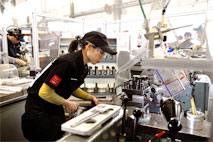
Focus
Technical Skill Contest
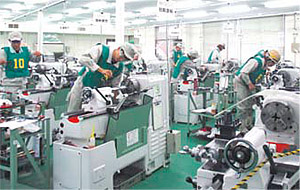
A pressing issue that has emerged in recent years at production facilities is the looming, full-scale retirement of baby boomers and the need to ensure that the knowledge and skills of veteran engineers are passed down to the next generation before they leave the factory floor. In response, we have been directing concerted efforts into training and skill improvement to cultivate young human resources in technical fields.
Every year, we hold a technical skill contest at the Akashi Works, kicking off what has become an annual event where young engineers from production sites at home and abroad compete with skills mastered on the job. In fiscal year ended March 31, 2017, participants from Japan and four other countries give their all, demonstrating accomplished skills in a fierce competition. It is a great learning experience for everyone.
Going forward, we will utilize this approach to maintain and further improve the skills of employees in production positions at companies throughout the Group.
Focus
Toward Enhanced Monozukuri Capabilities
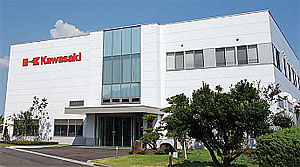
A severe shortage in experienced workers is looming. To address such challenges, we must aggressively promote the transfer of technical skills to enhance monozukuri production capabilities, which form the bedrock of our business activities.
Toward this end, we opened Takumi Juku, a professional trade skills academy training center at the Harima Works, in 2012, and Manabiya, a manufacturing skills creation center at the Akashi Works, in 2014. Through synergies with the existing skills academy-type training system applied to date as well as the creation of opportunities where these skills can be passed on to the next generation, these centers are delivering results as points for transferring skills, acquiring new skills, refining existing skills, and developing a pool of experienced instructors in a short period of time, which raises the level of expertise all around.
Developing Global Human Resources
Since 2008, we have been implementing measures for global human resource development, with the aim of furthering the development of human resources in support of global business expansion. Specifically, we provide overseas business manager seminars (at both beginner and intermediate levels) designed to promote a readiness to deal with business from a global perspective and teach useful skills for overseas business; enhanced cross-cultural responsiveness training, which instills a practical and systematic understanding of differences in ever-diversifying value perceptions; and global business mentality training for decision making, in which employees systematically study the requirements for global human resources through a reflection of their own overseas experiences.
Furthermore, we will work to enhance measures toward global human resource development through such means as introducing an overseas internship system aimed at globalizing domestic human resources and considering an educational program for local skilled employees at overseas sites.
Record of Main Training Related to Global Human Resource
Development Organized by the Head Office
(Year ended March 31, 2018)
| Overseas business training |
Response capabilities of different cultures training |
English skill series* | English writing series* | |
|---|---|---|---|---|
| Number of participants | 39 | 61 | 30 | 32 |
| Total number of hours | 2,964 | 488 | 648 | 512 |
* English skill series: meeting training (reading aloud and practice), presentation training, negotiation training
* English writing series: technical writing course, business writing training
Note: Language training is also carried out at other operating sites.
Matching the Right Person to the Right Job
Personnel positioning is planned based on the "right person to the right job" policy, in consideration of aptitude, skills, personnel allocation, and successor issues, etc.
To realize this "right person to the right job" positioning, we have established various system in which employees' wishes are respected to motivate and activate them. The Self-Report System is among them, in which system employees report their characteristics, strengths, current job aptitude, and transfer requests once a year. In addition, we have the Rotation System for developing specialists with broad knowledge and experience and the Company Open Application System (= Job Challenge System) for responding to the needs for special human resources in place, too.
To supplement these, the FA System* and the Inter-Company Human Resource Exchange System (Internal Exchange Study System) were newly established in 2012, aiming to further promote appropriate personnel positioning and development of human resources.
Moreover, the Human Resource Information Management System to support these systems were also newly established, which has been operated in full scale since fiscal year ended March 31, 2014. This is a system to visualize and keep track of the job experience and other relevant information, in addition to existing basic personnel information. This system has been helping us with the more advanced use of personnel information and the development and positioning of human resources.
* The FA System is a system supplementing the Self-Report System, in which employees declare to the entire company their wishes to transfer to other business segments or specific divisions, and the Company may match them with such business segments or divisions.
Promoting Diversity
Perspective on Diversity
Diversity is an important management issue for the Company from the perspectives of making the best use of the capabilities of its diverse human resources, fairness, and risk avoidance. We are developing a working environment that makes it possible to mutually recognize and take advantage not only of nationalities and genders, but also differences in sexual orientation, involvement with family care, values, lifestyles, and other factors.
We also set up a diversity promotion site—“Hibikiau Chikara” (Strength in Synergy)—on our corporate intranet. Here, employees can learn about diversity, view examples from the workplace, and gather information on systems to support a good work-life balance.
Ideas Infused into Diversity Symbol

Imagine Kawasaki operations as a tree, shaped by many people with different personalities.
The tree grows quickly, with leaves and fruit adding color, and it thrives. In the same way, we who work at Kawasaki are an assortment of colors, our unique personalities and skills dotting the landscape of Kawasaki—and we grow, not only as individuals but as a company.
Focus
Promoting Diversity Through External Links
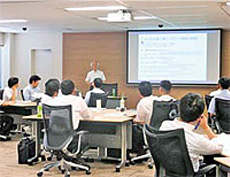
At Kawasaki, we believe promoting diversity and a good work-life balance are important components of management strategy, and we undertake activities toward these ends. In addition, to accelerate acceptance of these ideas within society, we enthusiastically participate in external study groups and work with other organizations and companies beyond a singlecompany framework.
A prime example of this is our involvement in the Research Project toward Realization of a Work-Life Balanced Society, a joint effort by Chuo Graduate School of Strategic Management and the private companies. The project’s objective is to convey the principles of the work-life balance concept widely through surveys and research. Kawasaki joined the project in 2013 and, as the model to follow, introduced work-life balance seminars for managers.
We are also a member of the Diversity Western-Japan Study Group, comprising chief diversity officers at companies in the Kansai region, The study Group Members share ideas and good examples of diversity in action and lobby corporate management and government to convey the principles of diversity concept widely. This study group coordinates the planning and execution of Pan-industry forums for company’s diversity and work life balance measures, for example, targeting female employees, employees in paternity leave and foreign nationals working in Japan.
Encouraging Greater Activity among Foreign Employees
In fiscal year ended March 31, 2013, Kawasaki began recruiting non-Japanese university graduates. We continue to search globally, with new employees coming primarily from South Korea, China, Sweden and Australia. Given this global recruitment perspective, we prepared guidebooks for people who work with foreign nationals and distributed the materials to relevant divisions to improve communication between non-Japanese employees and their superiors and workplace colleagues and to help Japanese staff better understand foreign nationals who have different religious and cultural backgrounds.
Change in Number of Foreign Nationals (administrative and technical position only, as of April 1 for each year) (non-consolidated)
| 2014 | 2015 | 2016 | 2017 | 2018 |
|---|---|---|---|---|
| 21 | 23 | 29 | 34 | 35 |
Promoting Participation by Women
For promoting participation in society by women, the Company hires women positively, in the first place. The numbers of women hired and those in managerial positions have been increasing year by year, and particularly in hiring, about 30 percent of the new college graduates in administrative positions are women.
In addition, we are also supporting the activities named "4U (For You) Network" of aimed at women widening the field of performance by learning from each other, where the participants can find good role models in the company and share wisdom to balance work with life events. In 2013 and 2014, the Carrier Design and Communication Training planned by the 4U (For You) Network was carried out for female employees and their supervisors. In 2016, furthermore, the Carrier Forum was held for approximately 180 women in management track positions who have worked with the Company for 10 years or less, where they learned how their seniors have made what they are now, and gave a thought to their respective career images in five years through the group discussion.
Also, considering the promotion of the appointment of women to managerial positions to be an important issue, we are working to develop more women resources with the target of "trebling by 2020 the number of women in managerial positions (section head or its equivalent or above) from fiscal year ended March 31,2015."
Number of Women in Managerial Positions (Section Head or Above; as of April 1 for Each Year) (non-consolidated)
| 2014 | 2015 | 2016 | 2017 | 2018 |
|---|---|---|---|---|
| 17 | 23 | 26 | 29 | 43 |
Note: Figures include staff on external postings and staff on leave.
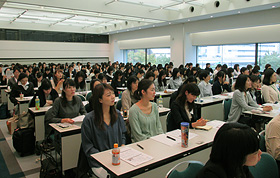
Focus
Kawasaki Receives “Eruboshi (Grade 2)” Certification (May 2016)
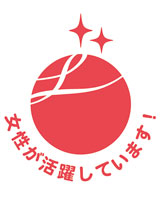
In May 2016, Kawasaki received “Eruboshi (Grade 2)” certification as an outstanding company for promoting women’s participation in the workplace.
The Eruboshi system is based on the Act on Promotion of Women’s Participation and Advancement in the Workplace, which went into full effect on April 1, 2016. Of companies that draw up and submit general employer action plans under the Act, only those subsequently judged to meet certain standards and provide excellent conditions to encourage women to be more active in the workplace, are eligible for certification by the Minister of Health, Labour and Welfare under the Eruboshi system. Kawasaki is the first company in Hyogo Prefecture to acquire certification.
Companies are graded on five criteria—1) hiring, 2) continuous employment, 3) working conditions, such as working hours, 4) ratio of women in managerial positions, and 5) career path diversity—and awarded one of three grades of certification depending on how many of the criteria they satisfy. Kawasaki fulfilled four of the criteria—1, 2, 3 and 5—to receive its Grade 2 certification.
We will set a numerical target the ratio of women in managerial positions—the condition we did not meet this time—in our general employer action plan, and strengthen efforts to reach this goal.
Promoting Participation by People with Disabilities
We are committed to hiring more people with disabilities, and they participate in a wide range of workplaces. In September 2013, we established Kawasaki Heartfelt Service Co., Ltd., which promotes the active employment of people with disabilities in the Group as a whole in order to maintain and improve the employment rate, and also works actively to create barrier-free workplaces. We are cultivating an environment where people with disabilities can develop their full potential.
Percentage of Disabled Employees and Number of Disabled People hired (As of June 1 for Each Year)
(Combined with Kawasaki Heartfelt Service Co., Ltd.)
| 2014 | 2015 | 2016 | 2017 | 2018 | |
|---|---|---|---|---|---|
| Percentage of Employees |
1.95% | 2.11% | 2.18% | 2.32% | 2.47% |
| Number of people hired |
341.5 | 374.5 | 391 | 420 | 451 |
Note: People working short hours are accounted for at a factor of 0.5.
Note: One severely disabled person is counted as two people with disabilities.
Topics
Kawasaki Heartfelt Service Co., Ltd. Obtained Certification of Outstanding Organization for Employment of People with Disabilities
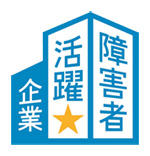
Kawasaki Heartfelt Service Co., Ltd., a special subsidiary of the Company established in September 2013, obtained the Certification of Outstanding Organization for Employment of People with Disabilities on March 29, 2018. The company was the ninth in Japan to receive the certification. It recognizes that the company takes advanced approaches to provide a workplace environment that supports retention of people with disabilities; promotes active and continuous hiring of people with disabilities; and is both a reliable and prosocial enterprise that promotes active participation by people with disabilities. The certification’s administration is entrusted by the Ministry of Health, Labour and Welfare to the Japan Association of Employers of Persons with Severe Disabilities. The certification is granted to companies that take outstanding initiatives for promoting active participation of people with disabilities, including implementing employment management and reviewing employment patterns by taking into consideration the individual characteristics of disabilities. The company will continue providing a work environment where people with disabilities can work with job satisfaction and promoting business activities they can actively participate in.
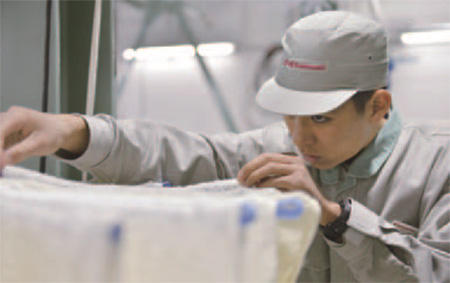
Title: “Concentration” (Minister of Health, Labour and Welfare Award-winning Work [Photo Section]) Original photo for the campaign poster for people with disabilities employment promotion month for fiscal year ended March 31, 2018 (Both the model and photographer are employees of Kawasaki Heartfelt Service Co., Ltd.)
Supporting a Balance of Child Care, Nursing Care, and Work
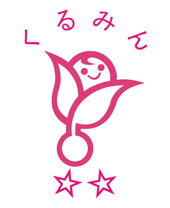
We have a number of systems to support raising the next generation and nursing care, in order to enable our employees to continue working actively while balancing work with childcare and nursing care.
Examples include a system of childcare leave available until employees’ children reach age three; a short-time working system available to employees with children until they graduate from elementary school; nursing care leave available for up to three years; holding seminars to support those on childcare leave who wish to return to work; a system whereby people can apply for reemployment when they are ready to return to work after resigning because of marriage, childbirth, child-raising, or other reasons; and a system that lets staff take time off in units of one hour at a time if needed to care for children or other family members. With initiatives in this area that go beyond national government standards, the Hyogo Labour Bureau certified us as a company supporting childcare, and awarded us the “Kurumin Mark” in 2010.
Also in fiscal year ended March 31, 2013, congratulations leave granted to male employees at the childbirth of their spouse was expanded from two days to five days to encourage them to participate in child-raising.
Moreover, our systems have been further enhanced by such means as newly introducing in 2012 the Supplementary Work Day Nursery Service to offer temporary childcare services within company on supplementary work days and the Childcare Rescue System to offer baby-sitter services as designated by the company for employees requiring childcare services including nursing for sick or recovering children and during overtime duties or business trips.
Number of Employees Using Childcare or Care Leave (non-consolidated)
(Years ended March 31)
| 2014 | 2015 | 2016 | 2017 | 2018 | |
|---|---|---|---|---|---|
| Childcare leave | 37 (2 men, 35 women) |
43 (4 men, 39 women) |
37 (9 men, 28 women) |
51 (8 men, 43 women) |
49 (6 men, 43 women) |
| Care leave | 0 | 2 (2 men, 0 women) |
2 (2 men, 0 women) |
0 | 4 (2 men, 2 women) |
Overview of Support Systems (non-consolidated)
| Parental leave before and after birth | Maternity/paternity leave | Employees may take leaves until a child reaches the age of three. There is no limit on the number of times leave can be taken. |
|---|---|---|
| Return to work support program “WIWIW” | Employees on maternity/paternity leave are provided with online services that enable them to get information and other materials to support their return to work, or allow them to enhance business skills, or promote communication with their office colleagues. | |
| Leave to care for sick/injured child | Employees receive five days each year for each child up to completion of elementary school. Kawasaki does not set a limit on the number of children used to calculate a five-day leave. (Legally,companies are only required to provide a total of up to 10 days per year to employees with two or more children.) | |
| Half-days off | Employees may take as many half-days off as necessary,within available annual paid leave, to care for a young child (up to completion of elementary school) or when morning sickness interferes with job duties. | |
| Accumulated leave* | Employees may use accumulated leave to care for a young child (up to completion of elementary school), care for a sick/injured child, or when morning sickness interferes with job duties. | |
| Use of flextime system | Employees may work on a flextime basis as necessary when looking after a young child (up to completion of elementary school) or when morning sickness interferes with job duties. | |
| Limits on out-ofhours work and work on days off | Employees may be exempted from out-of-hours work and work on days off until a child completes elementary school. | |
| Reduced working hours to care for young child | Standard working hours can be reduced up to a maximum of three hours a day until a child completes elementary school. | |
| Family (Nursing) care | Nursing care leave | Employees may take leave up to three times for one person requiring nursing care (three years at longest). |
Limits on out-of-hours work and work on days off for nursing care |
Employees may be exempted from out-of-hours work and work on days off up to once a year. | |
| Special leave for family care | Employees may take special leave of five days to care for an ailing or elderly family member. Kawasaki does not set a limit on the number of family members that employees must care for. (Legally, companies are only required to provide a total of up to 10 days per year to employees who have two or more family members in need of assistance.) | |
| Half-days off | Employees may take as many half-days off as necessary,within available annual paid leave, to care for an ailing or elderly family member. | |
| Accumulated leave* | Employees may use accumulated leave whenever necessary to care for an ailing or elderly family member. | |
| Use of flextime system | Employees may work on a flextime basis as necessary when looking after an ailing or elderly family member. | |
| Short-time working system for nursing care | Employees may shorten their working hours for at longest two hours a day (up to two times in three years). | |
| Other | Request for reemployment | Employees who resign to care for a child or an ailing/elderly family member may apply to be rehired when a change in their situation allows them to return to work. |
* Accumulated leave refers to annual paid vacation days that could not be carried over to the next year but can be taken in special circumstances.
Topic
Enhancing On-site Nursery Facilities
A nursery opened at Kawasaki Motors Enterprise (Thailand) Co., Ltd. in April 2010. The nursery provides temporary care for employees’ children between the ages of one and four. As of March 2017, the nursery cares for the children of about 30 employees on a daily basis. Several more children are also registered at the nursery, and utilize it as necessary. The nursery is generally open from 7:30 to 17:15 to coincide with regular working hours, but if requested by more than a fixed number of employees, it is also made available during overtime or holidays.
The opening of the nursery means that parents can continue working with complete peace of mind, having left their children to be cared for nearby. From the employer’s viewpoint as well, the loss of skilled human resources due to childbirth or childcare is avoided, promoting a stable and committed workforce. The opening of the nursery has thus proved to be a measure with mutual advantages.
In Japan, meanwhile, we provide nursery facilities at the workplace on supplementary work days to offer childcare for limited periods.

Utilization of elderly persons
Kawasaki began action to extend the retirement age before the legal requirement was introduced by the revision of the Older Persons’ Employment Stabilization Law. Thus, in April 2006 the fixed retirement age for general employees was set at 63 through agreement between labor and management.
In addition, we operate a post-retirement reemployment system that in principle makes available post-retirement reemployment up to age 65 to all those who request it. These policies allow many veteran employees to remain involved in active operations where they can use their rich store of experience and pass on their skills.
Employees who have reached age 55 are invited to participate in a “Lifestyle Design Seminar,” which offers them the opportunity to find out about our schemes for postponing retirement and seeking reemployment and to consider afresh their lifestyle options following reemployment.
Number of People Rehired (non-consolidated)
(Years ended March 31)
| 2014 | 2015 | 2016 | 2017 | 2018 |
|---|---|---|---|---|
| 150 | 167 | 214 | 243 | 183 |
Contact
If you need more information about our business,
please feel free to contact us.





